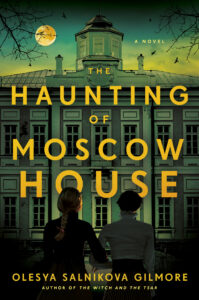When most people think of gothic fiction, they envision a heroine dashing through a crumbling manor in middle of nowhere England, chased by the ghosts of her lover’s past, one as rife with secrets as the holes in her moth-eaten gown.
19th and 20th century classics such as Bronte’s Jane Eyre, du Maurier’s Rebecca, and Austen’s Northanger Abbey come to mind, as well as monster gothics like Shelley’s Frankenstein and Stoker’s Dracula. Many in non-publishing tend to believe the genre is as dead as these authors, maybe excepting fans of Guillermo del Toro’s 2015 gothic masterpiece Crimson Peak.
When I tell my non-publishing friends about my new book, The Haunting of Moscow House, a gothic horror set in post-Revolutionary Moscow, their first question is WHY. Why gothic fiction? Why write such a story at all? First of all, why not gothic fiction?
It doesn’t have to be the same old iteration, though that can be delightful in its own way. After all, the genre is more relevant to us now more than ever. Gothic fiction and, more broadly, horror, shows us the darkness within ourselves and our worlds. And since our world today seems very dark indeed, it reflects our deepest, greatest fears, our most insecure vulnerabilities as humans. It horrifies, it entrances, it romances, it invites escape, all in equal measure. Like other genres, gothic fiction doesn’t need to be static. It can change with the times, encompassing our modern realities, sensitivities, and preoccupations. And it has.
We have started to write and read gothics that incorporate new cultures, as well as new settings and historical time periods, with strong feminist heroines and modern perspectives, thereby pushing the boundaries of traditional gothic fiction to remake it. As something relatable, as a safe lens through which we can discuss real issues. Here are some books from the last four years or so (out of many) reshaping the gothic as a genre and adding their own unique twist.
___________________________________
International Gothic
___________________________________
It’s impossible to talk about recent changes in the genre without Silvia Moreno-Garcia’s 2020 Mexican Gothic. On the outside, a socialite travels to a remote mansion in the Mexican countryside to help her newly married cousin with a mysterious problem. But it is so much more, incorporating race and politics, colonialism, a woman of color as a protagonist. I was drawn into the vivid 1950s Mexican setting and culture, which I had not then seen in gothic fiction, and the plucky, resilient take-no-shit heroine that defied the genre’s stereotypical main character.
Likewise, Isabel Cañas’s The Hacienda is set in Mexico following the War of Independence. While the idea—a young woman moving into her new husband’s haunted home—is familiar, the story is anything but. In it, Cañas brings her knowledge of Mexico as she explores not only this fascinating period in history, but family and class dynamics, as well as all the delicious details of her culture. I just loved how she infused culture into the everyday life and atmosphere of the house and its hauntings, making for a truly unforgettable read.
I was inspired by both Moreno-Garcia and Cañas when I wrote Moscow House, about two once aristocratic sisters as they race to uncover the secrets buried in their family’s now haunted house, by incorporating my Russian heritage and culture, as well as Slavic gothic elements and lore. And by challenging the idea that gothic fiction must be set in a remote place, instead choosing 1920s urban Moscow. It might be a ghost story, but it is also about a society on the cusp of change, a persecuted people now forgotten, a female-centric story of survival and sisterhood.
___________________________________
Domestic Gothic
___________________________________
New cultures can be explored here at home, too.
In The Witch of Tin Mountain, Paulette Kennedy explores her native Ozarks in Depression-Era Arkansas to weave a feminist generational story about granddaughter and grandmother, as well as class and female friendship and romance. My favorite parts were seeing how people of that time and place lived, as well as the region’s mysterious folklore and history that Kennedy weaves in so seamlessly.
Similarly, Wendy Webb is known as “the queen of Midwest gothic fiction,” most recently, The Stroke of Winter. I am also from the Midwest, and as soon as I discovered Webb, I read her novels voraciously. Her stories are typically set in the Great Lakes and feature folklore, culture, and history from the region. They center on women wrangling with haunted old lake houses and the modern yet age-old themes of finding and losing love, motherhood, and family trauma.
Chanel Cleeton sets The House on Biscayne Bay in Southern Florida. It is about the unhappy wife of a wealthy industrialist following the Great War and two Cuban sisters living in the same house years later. I loved the cultural elements not only in the story and the protagonists, but also in the setting and atmosphere—the oppressive heat, the haunting peacocks roaming the eerie property, the alligators slithering out of the shadows. It was so contrary to sunny, seemingly non-gothic Florida that I loved every minute.
___________________________________
Fresh Settings & Time Periods in Gothic
___________________________________
Some gothics might not delve into a new culture per se but are still set in rarely seen countries and time periods—or make up entirely new ones.
Alexis Henderson sets The Year of the Witching in the fictional town of Bethel, where a young woman discovers the power within to fight against her puritanical society. I thought this fictional world was dark, atmospheric, and disturbing, with alarming A Handmaid’s Tale echoes to our own reality, besides for boldly exploring issues such as race, class, and gender.
The Woman in the Castello, by Kelsey James, is about a struggling American actress and mother who takes on a starring role in a horror movie shooting in a medieval castle outside of Rome with mysterious ties to her family. The premise is unique, the 1960s setting glamorous, the crumbling Italian castle nice and gothic.
Katherine Arden’s The Warm Hands of Ghosts, about a combat nurse searching for her brother, is set during World War I. I haven’t seen a gothic set during this time and certainly not in the very trenches and hospitals of one of 20th century’s most harrowing conflicts. It may be a ghost story, but it is also about the strong bond between siblings and the trauma of war and death. I loved learning about a war oftentimes eclipsed by the one that followed.
Honorable mention goes to several contemporary gothic novels that highlight very important, relatable modern issues and relationships: T. Kingfisher’s A House with Good Bones focuses on a mother daughter relationship in the wake of family trauma; Carissa Orlando’s The September House also has a mother daughter relationship at its center but with a psychological kick; and Grady Hendrix’s How to Sell a Haunted House looks at sibling relationships and trauma.
It’s a joy to read classic gothic literature, even its nostalgic reincarnations, but this is a ripe, exciting time to explore the genre through the lens of new cultures, settings, time periods, and perspectives, adding to it a much-needed twist.
***


















